Gird your loins: London Fashion Week is back - and with it, a season that reminds us why the capital remains fashion’s bubbling nerve centre. Where Paris and Milan boast mega brands, London thrives on firsts, where creative risk proves viable and emerging names share the stage with established voices.
The biggest debut isn’t on a runway but in the boardroom: Laura Weir, former ES Magazine editor-in-chief, takes her first bow as CEO of the British Fashion Council. In a few short months, she has waived schedule fees, extended NewGen funding, and doubled down on the international guest programme. The results: an 18% rise in on-schedule shows and renewed energy among young designers who might otherwise be priced out.
Thursday opened with fireworks. H&M staged its official LFW show, complete with nu-supers and a Lola Young performance. eBay followed with its ‘preloved is luxury’ catwalk, and Harris Reed delivered his signature spectacle. It set the pace for a week buzzing with invention.
The weekend belongs to NewGen. The cohort includes 19 names, with seven newcomers: Aaron Esh, Aletta, Charlie Constantinou, Derrick, Ewusie, Johanna Parv, Karoline Vitto, Kazna Asker, Liza Keane, Lueder, Louther, Oscar Ouyang, Octi, Pauline Dujancourt, Steve O Smith, The Ouze, The Winter House, Tolu Coker, and Yaku. This platform, now supercharged under Weir, continues to be London’s most vital pipeline of talent.
The schedule reads like a matriarchy. From NewGen designers to Priya Ahluwalia, Talia Byre, Chopova Lowena, Dilara Findikoglu, Tove, Simone Rocha, Emilia Wickstead, Roksanda and Edeline Lee - women are shaping London Fashion Week with conviction. Daniel Fletcher also flexes his tailoring at Mithridate, sharpening the Chinese label’s London presence.
Milestones mark the week. Fashion East, the incubator founded by Lulu Kennedy and Raphaelle Moore, turns 25, celebrating alumni like Jonathan Anderson, Martine Rose, and Grace Wales Bonner while pushing forward its next wave. Roksanda and Erdem both celebrate 20 years, with Erdem releasing a Rizzoli tome to mark the occasion.
Elsewhere, Conner Ives, Jawara Alleyne, Paolo Carzana and Aaron Esh underline London’s knack for fearless reinvention. Jonathan Anderson skips the runway, but Burberry’s Daniel Lee promises to close with a blockbuster. London, more than ever, proves creativity is the capital’s true luxury.
As London fashion week Spring/Summer '26 has officially begun, team Grazia reports on all the highlights as they happen.
Burberry
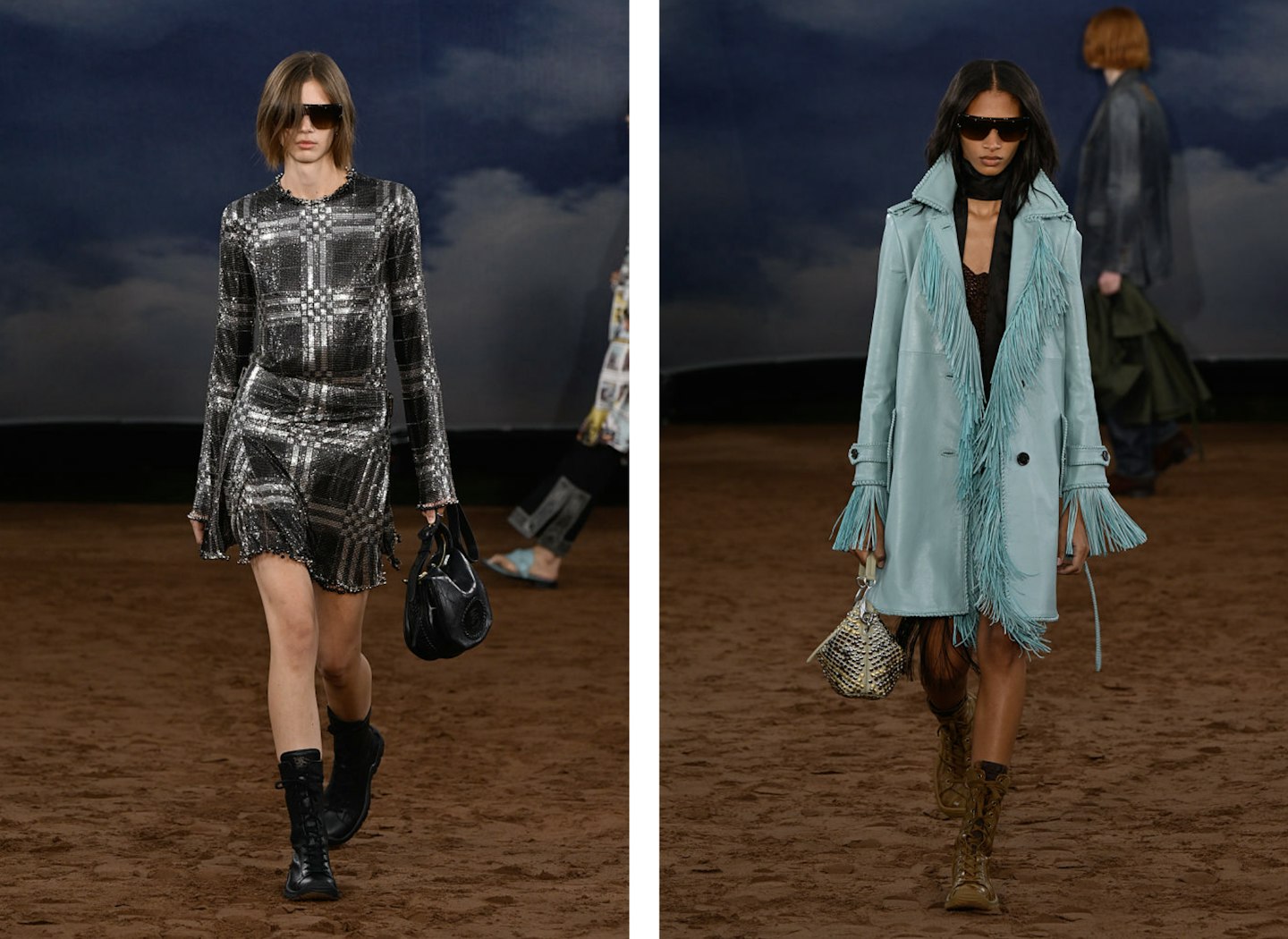
Burberry brought London Fashion Week to a close last night with a festival-ready collection that leaned into a rock-and-roll vision of Britishness. The show, held under a giant tarpaulin in Kensington Palace Gardens, set the scene with a Black Sabbath soundtrack and a sandy floor, evoking the mud and spirit of Glastonbury.
With a who’s who front row of national treasures – Jennifer Saunders and Joanna Lumley sharing an Ab Fab reunion, Alexa Chung and Pixie Geldof, Sir Elton John, Jodie Turner Smith, Jonatha Bailey, Raye, Lila Moss and Naomi Campbell – it was a case of great British brands supporting, well, a great British brand.
This was Daniel Lee’s sixth collection and he chose to showcase crochet dresses, fringed jackets and tailored suits in a palette of acid green, yellow and pink. The classic Burberry trench was reimagined in shorter (bum-skimming, in fact) rain macs and appeared in prints like snakeskin and tarot cards, while bumper sized fringed bags and hiking boots finished off the outdoorsy look. There were shimmering tunics of silver and gold and checked trousers with embroidered hems. But as ever, the presentation emphasised a sharp focus on Burberry’s well-trod tropes: macs, checks, scarves (here, skinny) along with outerwear, this time infused with a Wolf Gillespie (who was modelling) edge. RL
Conner Ives
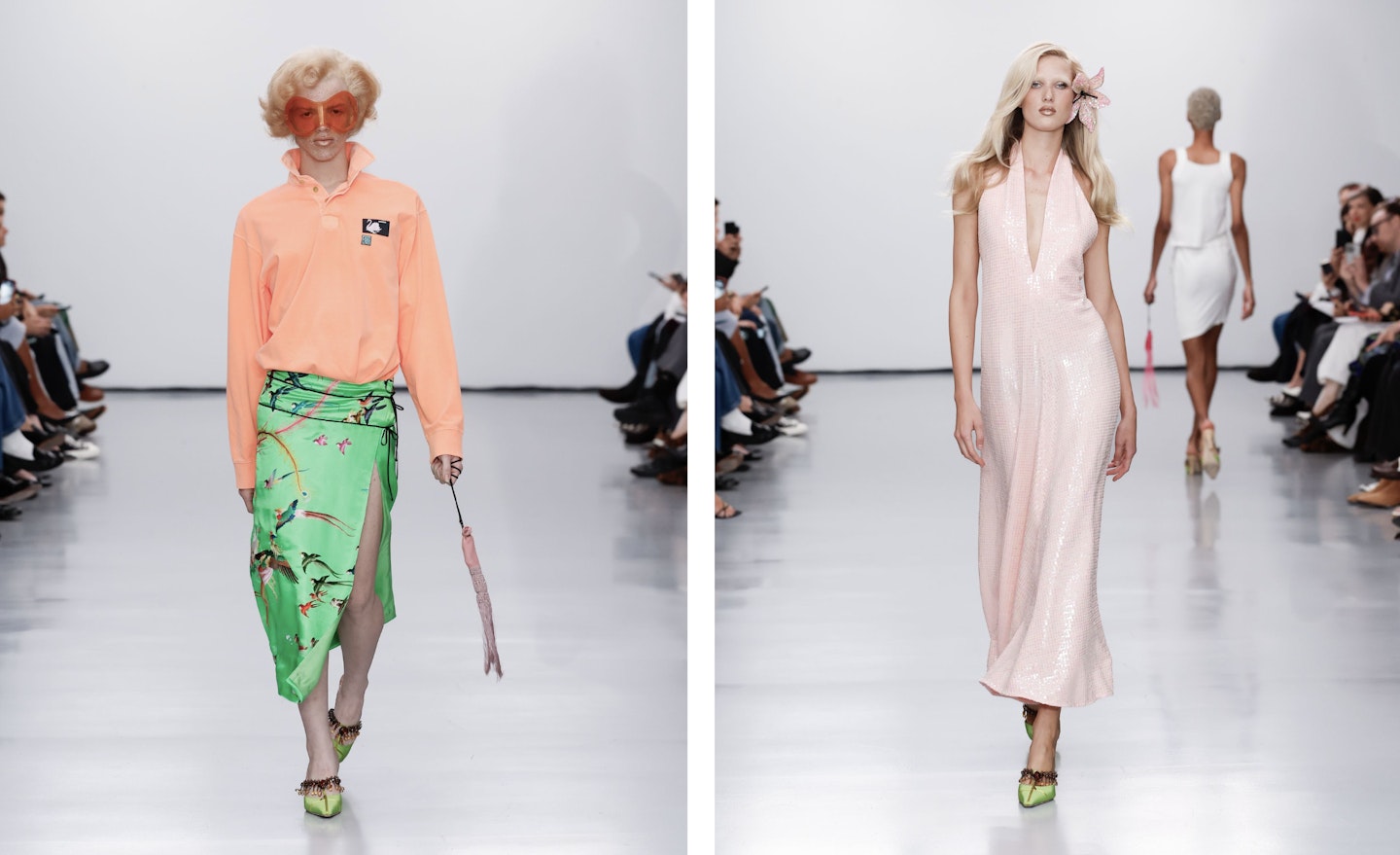
Since stepping out on the catwalk in February wearing his ‘Protect The Dolls’ T-shirt, Conner Ives has raised over $600,000 for the charity Trans Lifeline. The outing was - not that anyone ever doubted it - anything but performative. And if his emotional and truly special spring/summer ’26 show proved anything, it’s that Ives is a man of actions, not just empty words. Fashion doubters, take that.
Fresh from winning the Vogue/BFC Fashion Fund earlier this year, Ives delivered a collection that underscored why he is one of London’s most vital voices. The models? The nu it girls: Cortisa Star, Iris Law, Alva Claire and Osman Ahmed. The soundtrack? Uffie, Lady Gaga, Nelly Furtado, Robyn and Candi Statton. ‘POP MUSIC WILL NEVER BE LOW BROW’read the show notes.
The clothes: in Ives’s words, ‘neon dipped house codes, acid dipped rugbys.’ A Malibu Barbie pink sequin dress paired with Versace-esque ’90s hair and makeup; slinky bias-cut gowns (an Ives staple); deep V-necklines; scale-like sequins that rustled as they moved; Jimmy Choo heels; milkmaid tops, tasselled skirts and tiny bloomer shorts.
This time, the designer didn’t step out in a slogan tee, but in the iconic Lady Gaga MAC Viva Glam campaign T-shirt - another stealth nod to one of his great loves: pop music. On a Monday afternoon, he gave London a show that left everyone smiling, reminded that fashion can still do good when it wants to. His last word? ‘This one, and every one, is for my Dolls!’ HL
Paolo Carzana
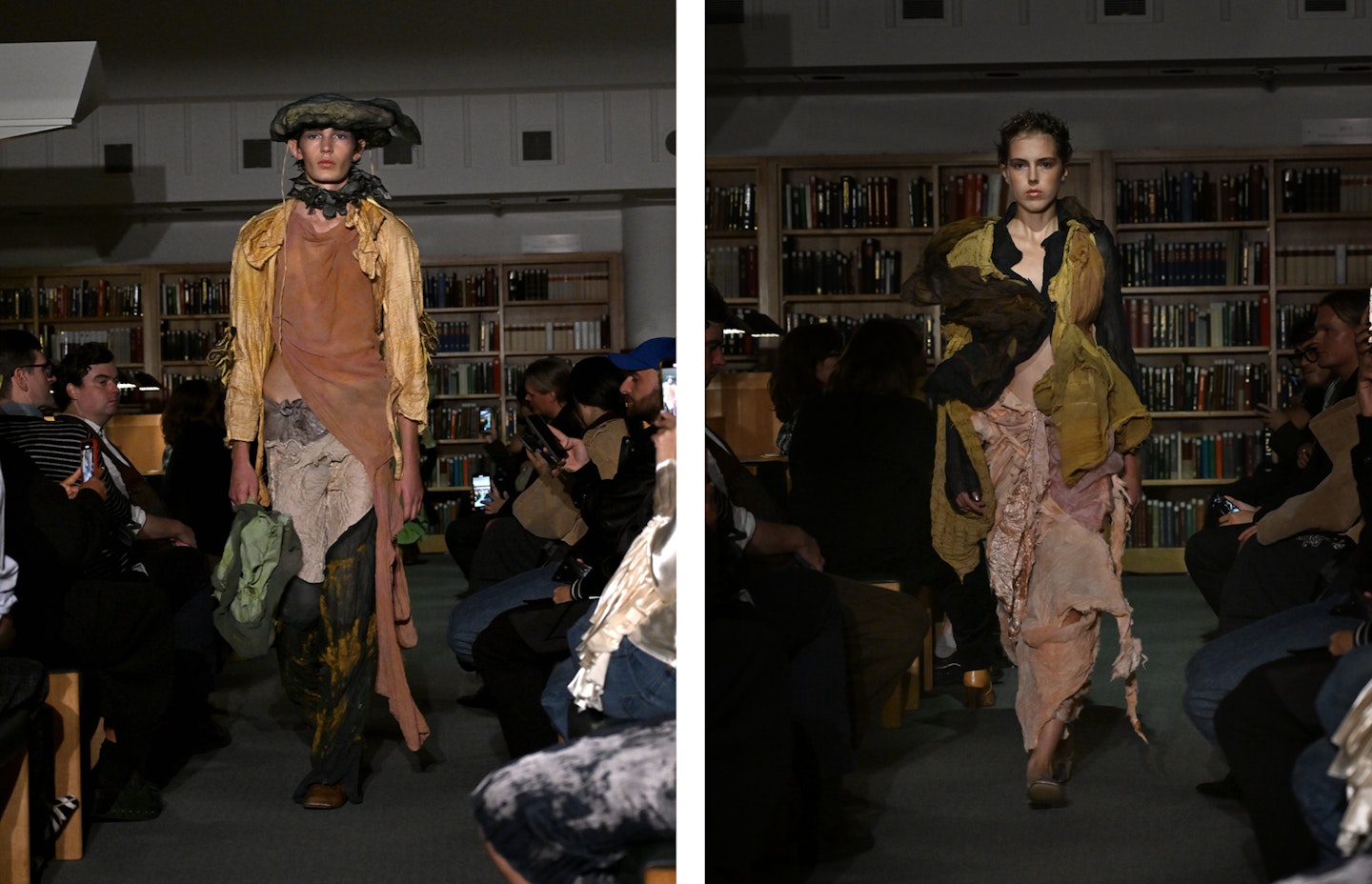
Paolo Carzana went from his back garden in east London, to a pub, and this season, to the British Library. What else to do when ticket requests multiply exponentially each time? The venue must scale up, but Carzana - a grafter if ever there was one - hasn’t lost sight of what matters. He didn’t inflate the show into spectacle simply because more eyes were watching. His spring/summer ’26 collection remained quintessentially him, and, as one editor remarked afterwards, it was ‘one that felt like fashion used to feel.’ Garden, pub or library reading room, that thread of intimacy has run through all his presentations so far.
Known for his deeply poetic, hand-worked approach to clothing, this latest outing extended his craft with conviction. Instead of the usual bombast, an atmospheric score lifted from a David Attenborough ocean documentary set the scene. To it, the Welsh designer unveiled a series of looks that channelled the supernatural splendour of the natural world, drawing on the forms of its most extraordinary and threatened inhabitants: rare salamanders, lizards, pangolins.
Models drifted quietly between library rows, their presence less like a runway parade than an apparition. The effect was hypnotic - garments alive with texture, detail and meaning, yet never drowning in concept. And true to what many guests whispered on their way out, it was fashion as it ought to be: not spectacle for spectacle’s sake, but a reminder of the magic of craft and the possibility of beauty in the strangest of places. HL
Dilara Findikoglu
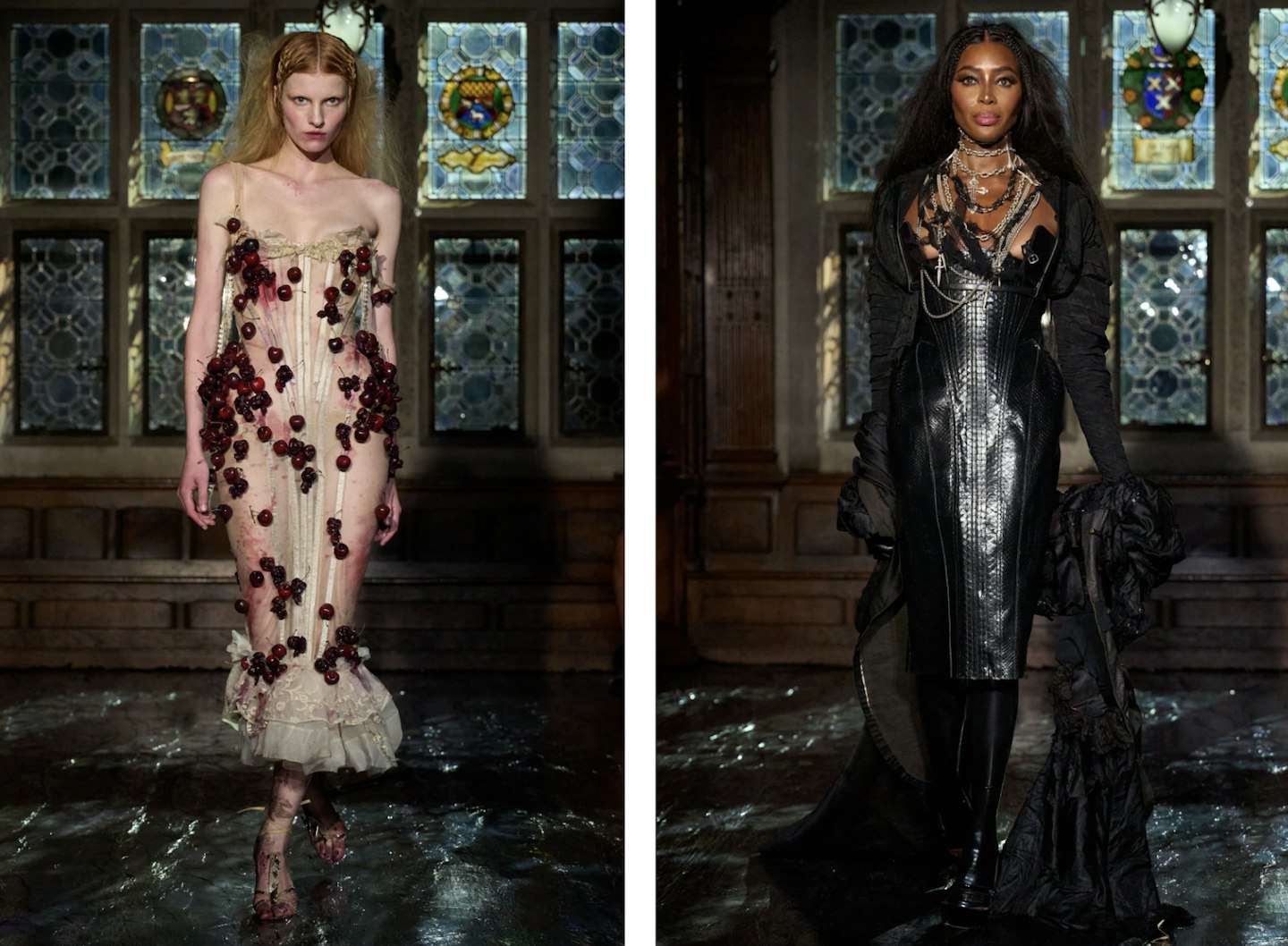
Standing outside the Barbican venue, waiting - and waiting - for the Dilara Findikoglu show to start, offered approximately one hour and a half to study the crowd. Primal Scream’s Bobby Gillespie was there alongside a crew of corset-clad, bruised leather-wearing, heel-teetering women and men, shivering in the cold.
The scene recalled the 1990s when Alexander McQueen first showed in London and would often keep his guests waiting outside some dank warehouse, obliviously finishing off a corset or whatever, which had the effect of ramping up the excitement to fever pitch before anyone had even set foot in the venue. A modus operandi that Dilara Findikoglu seemed to wish to emulate last night.
So what to make of an aesthetic that runs so very close to that of the late McQueen? As a woman designer, Findikoglu, has way more freedom to question feminine agency than that of her male predecessor (who was initially lambasted for it) and that gives her work a different dimension and tension altogether.
Deconstructed corsetry and unravelling gowns were literal embodiments of gothic glamour and brutal elegance. All amped-up to great effect by her models who stalked the maze of rooms with arched backs and challenging stares, brushing past the knees of the audience. All the better to see the spiralling seams of Gothic gowns, pattern making in a nude latex hobble skirt or the armour-like corsets which sliced fragility with ferocity. Only Naomi Campbell, offered a slightly knowing shadow of a smile as she strode around in a wet-look black corset skirt, latex boots and trailing what may have been a long black mac on the floor behind her.
Findikoglu’s artistry shone through with silicone-cherry adornments, safety-pin breast and hip plates, and tattoo-embellished leather, every piece a testament to a passion for storytelling and craftsmanship. Transcending mere 1990s nostalgia, she infused the proceedings with her Turkish heritage – namely silver coin masks and other hardware that spoke to her personal narrative. It’s easy to see why her designs have garnered such a celebrity cohort including Kim Kardashian, FKA Twigs, and Bella Hadid.
It will be interesting to see how long her impact will resonate within London’s fashion underground. Findikoglu navigates a well-trodden path of Gothic subversion in a landscape often dominated by commercial pragmatism, but it is her unapologetic voice that currently secures her place as a powerful force in London’s firmament. RL
Erdem
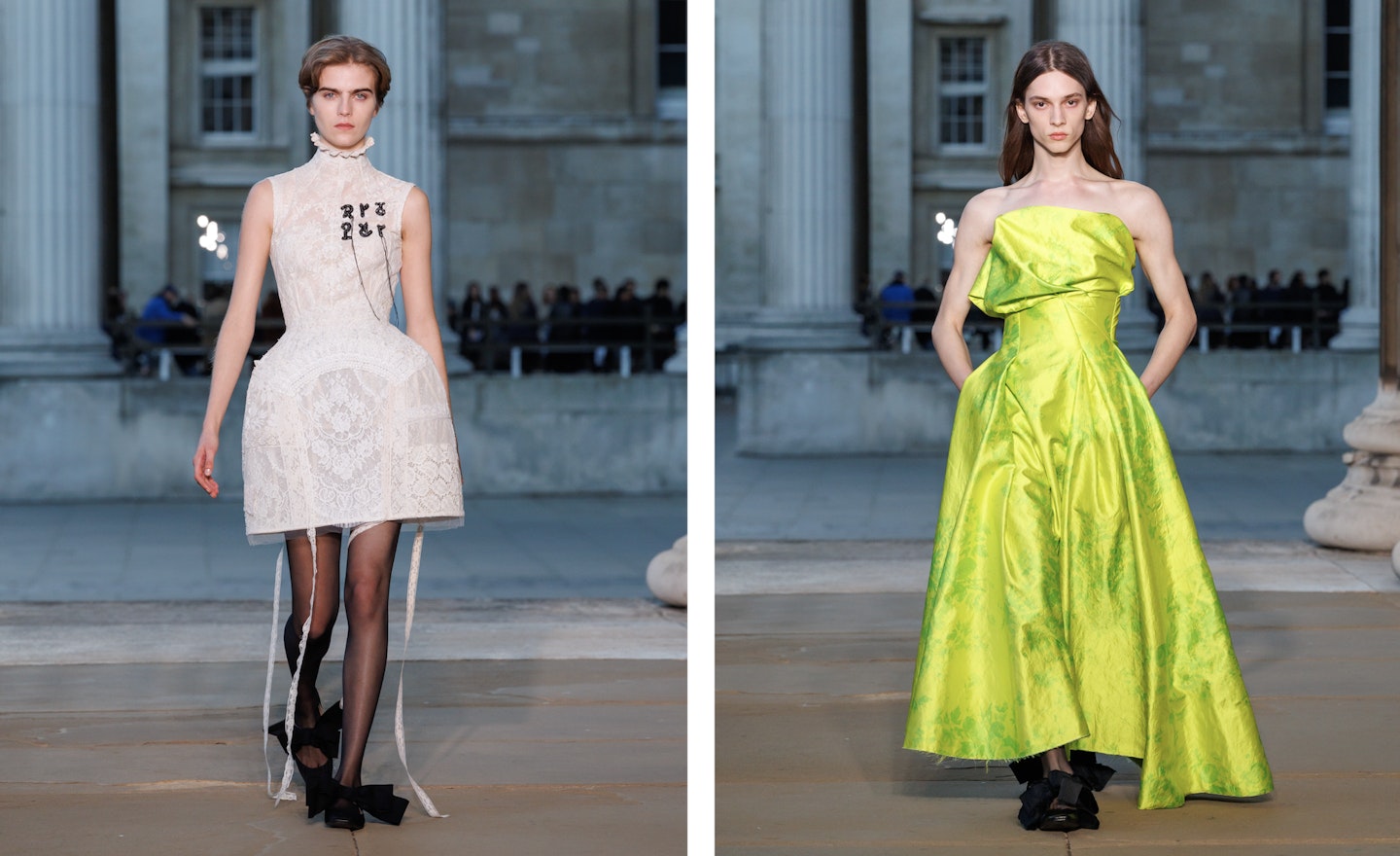
Erdem Moralioglu has long been a master of mining history’s margins - the overlooked figures, forgotten stories, the tiniest details - and translating them into painstakingly crafted garments that have become his shorthand. For spring/summer ’26, his research led him to Hélène Smith, the 19th-century Swiss medium who, through her trances, believed herself to have lived other lives: as a member of the French court, an Indian princess, and even a traveller under Martian skies.
Discredited in her own time, it was this triptych of selves that Erdem reimagined, not with cynicism but with admiration for a woman who insisted on reinvention. Crinoline dresses worthy of the V&A’s current Marie Antoinette exhibition brushed up against jolting minis, intricate embellishment and shocks of saturated green and pink. A sun-faded coat appeared, crusted with crystals and embroidery, nodding to his previous Barbour collaboration. Antique lace threaded through hourglass gowns; quilted corsets cinched the waist; florals bloomed across signature mid-length dresses. There was a single-breasted tuxedo jacket worn with drawstring trousers, cotton poplin shirts trimmed with lace, draped gowns in linen gauze, and hand-crocheted dresses dusted with crystals - a reminder this was, in fact, a summer offering.
Unlike his muse, Erdem himself requires no reinvention. His steadfast language - beloved by customers, editors, onlookers - is precisely what has carried his independent label to its 20th anniversary, an accolade (as a sobering matter of fact) few London designers can claim. Season after season, he proves why: garments as wearable as they are artful, and a presence as enduring as London Fashion Week itself. HL
Simone Rocha
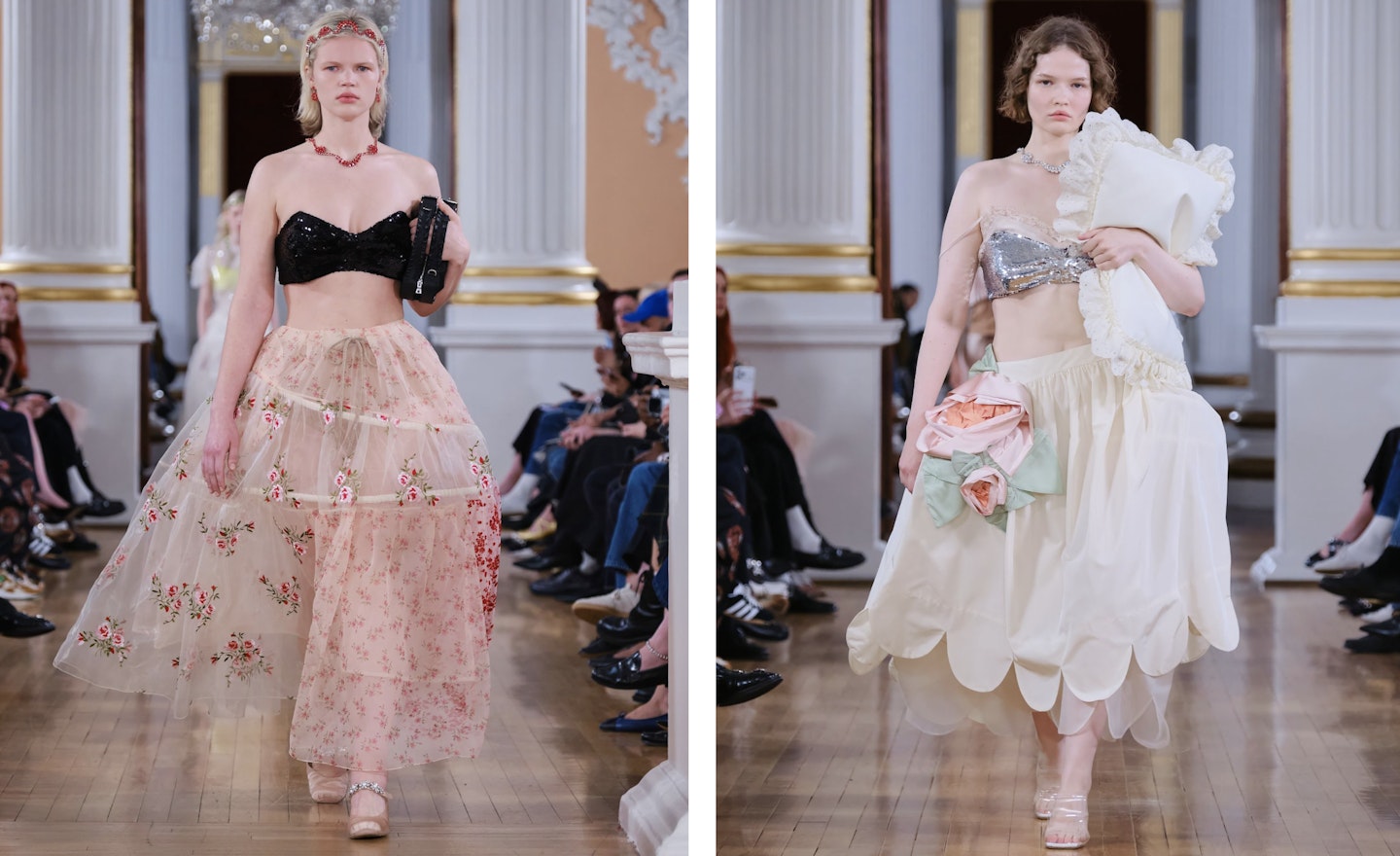
Simone Rocha’s collection, presented at London’s historic Mansion House, was an exploration of her enduring dialogue: subversion and girlish sweetness. This season, she introduced the ‘disgruntled debutante’, a character inspired by a 1992 essay who embodied a potent tension between rebellion and romantic tradition. Models, their arms folded petulantly or sometimes clutching satin pillows, stormed the runway in a collection that was as fiercely pretty as it was cleverly provocative.
Rocha’s signature tropes were refined and amplified. Voluminous hoop skirts (everywhere this week) and delicate embroideries were spliced with utilitarian PVC raincoats and rubbery footwear, including her cult Crocs collab. The clash of fragility and functionality made for a compelling narrative of modern femininity – protected yet exposed, elegant but always rebellious.
‘I wanted to look at my fundamental codes and really push and pull them,’ she said. That’s why the pearls were reimagined here with a harder edge, why the sweetness was paired with silver sequins or a sweatshirt tied around the waist, and why all her tulle and lace layers continue to be seen through a rigorous and conceptual lens. Drawing from memory, she also sweetly noted that she used to wear Odette, her mother’s petticoats and hoop skirts, hoisting them up to her armpits and wearing them as dresses. As ever, an autobiographical nod to family – and make no mistake, this is a family business.
But the ‘family’ is now global. You only have to look at the Simone Rocha tribe – the faithfuls who rock up to her show every season looking absolutely brilliant in their pearl punctured leathers, slashed ribbon skirts and moulded rubber footwear – to understand these are clothes for all ages, all sizes, all women. And what a pleasingly rebellious community it is. RL
Conner Ives
Talia Byre
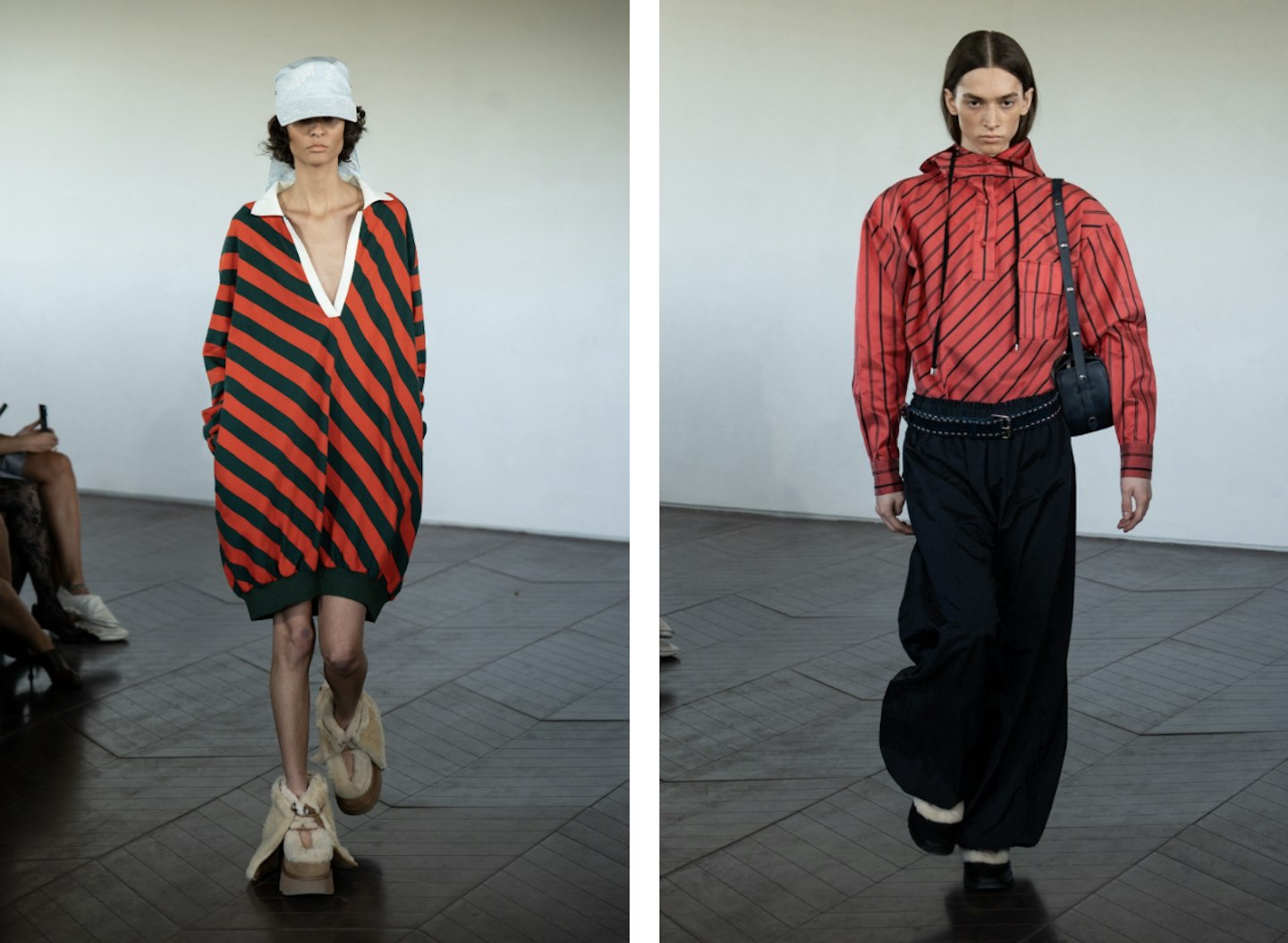
Not much will coax fashion editors to south London at 10am on a Sunday. On day four of London Fashion Week, sunshine helped - as did the chance to see what Talia Byre has been working on in her studio these past months.
Fashion runs through Byre’s veins: her great-uncle helmed the legendary 1960s Liverpool boutique Lucinda Byre. Not that she needs the pedigree. She has carved out a vocabulary all her own - colourful, directional, original - and, as proved this morning, a crowd-pleaser.
The venue: a sun-drenched glass-walled apartment. The mood: intimate but ambitious. Stripes - her signature, jolting in colour - opened the show, followed by knit bodysuits, leggings, paisley polo shorts and a slip of a dress that hinted at sleepwear. Gathered skirts in powder blue and vinyl black, a beaded top, and riffs on chic tracksuits built out the story. A rugby shirt dress added punch. Low-backed apron dresses in colour-blocked drapes nodded to her bridal line, while boxy leather bags and wide belts - already industry darlings - anchored the looks. Furry UGGs completed the uniform.
Her manifesto? ‘The clothes I want to wear.’ Apt: the audience left plotting shopping lists before they’d even descended the four flights of stairs. Few collections can generate that immediacy. Byre’s did. HL
Aaron Esh
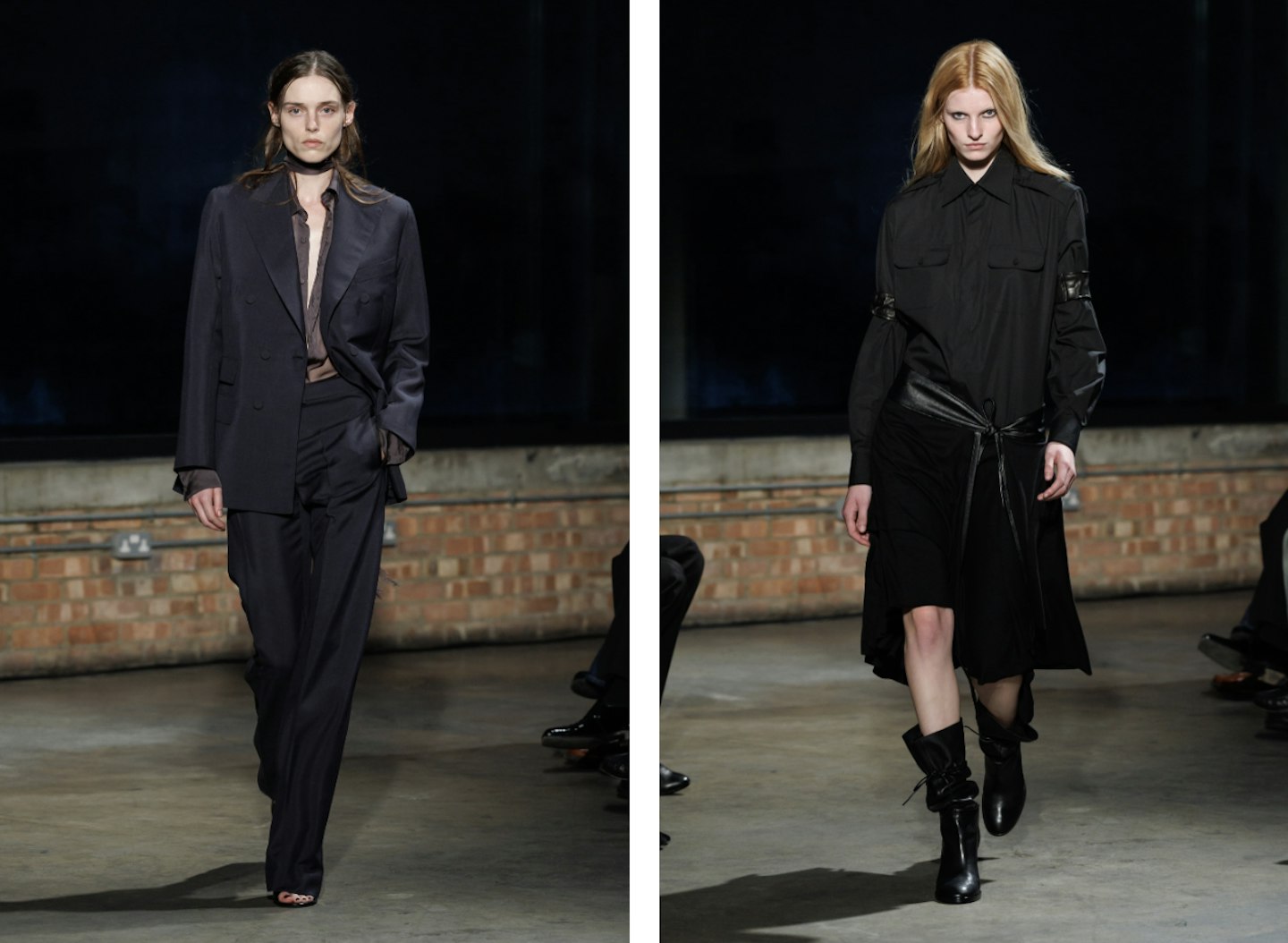
Aaron Esh’s spring/summer ’26 show was one of those rare London Fashion Week moments when the alchemy works: the clothes, the casting, the warehouse venue in Hackney, even the crowd - all fused into a mood that felt charged, fleeting, momentous.
Over the past few seasons, the east London–based designer and 2023 LVMH Prize finalist has unassumingly become one of the city’s most magnetic propositions. His aesthetic - skinny, sharp, subversive with a faint romantic streak - is mirrored by a community that feels authentically aligned. Precision is his calling card. Even before the models stepped out, their silhouettes flickered behind dimly lit windows, teasing what was to come to a thumping soundtrack.
The silhouette was familiar, but sharpened: elongated, insubordinate, evoking the ghost of heroin chic. Double-breasted suits and skinny leather trousers sat alongside cocooning coats, sweatshirts, hoodies, jeans, military shirt-dresses, suede jackets, bias-cut slips. Punkish, but young, restless, now.
Details clinched it. Jeans worn with a blazer and a featherlight frayed scarf; dresses traced with the same raw edge. Sequins scattered sparingly across wool; piping marking sweatshirts; shirts unbuttoned, tucked just so. Festival passes hung from necks, baseball caps crowned evening gowns.
Clothes you want to wear - cooler than cool, instinctive, rebellious, the essence of London style. A melting pot distilled into something exacting, seductive, chic. Proof, if needed, that Esh isn’t arriving. He’s arrived. HL
Mains
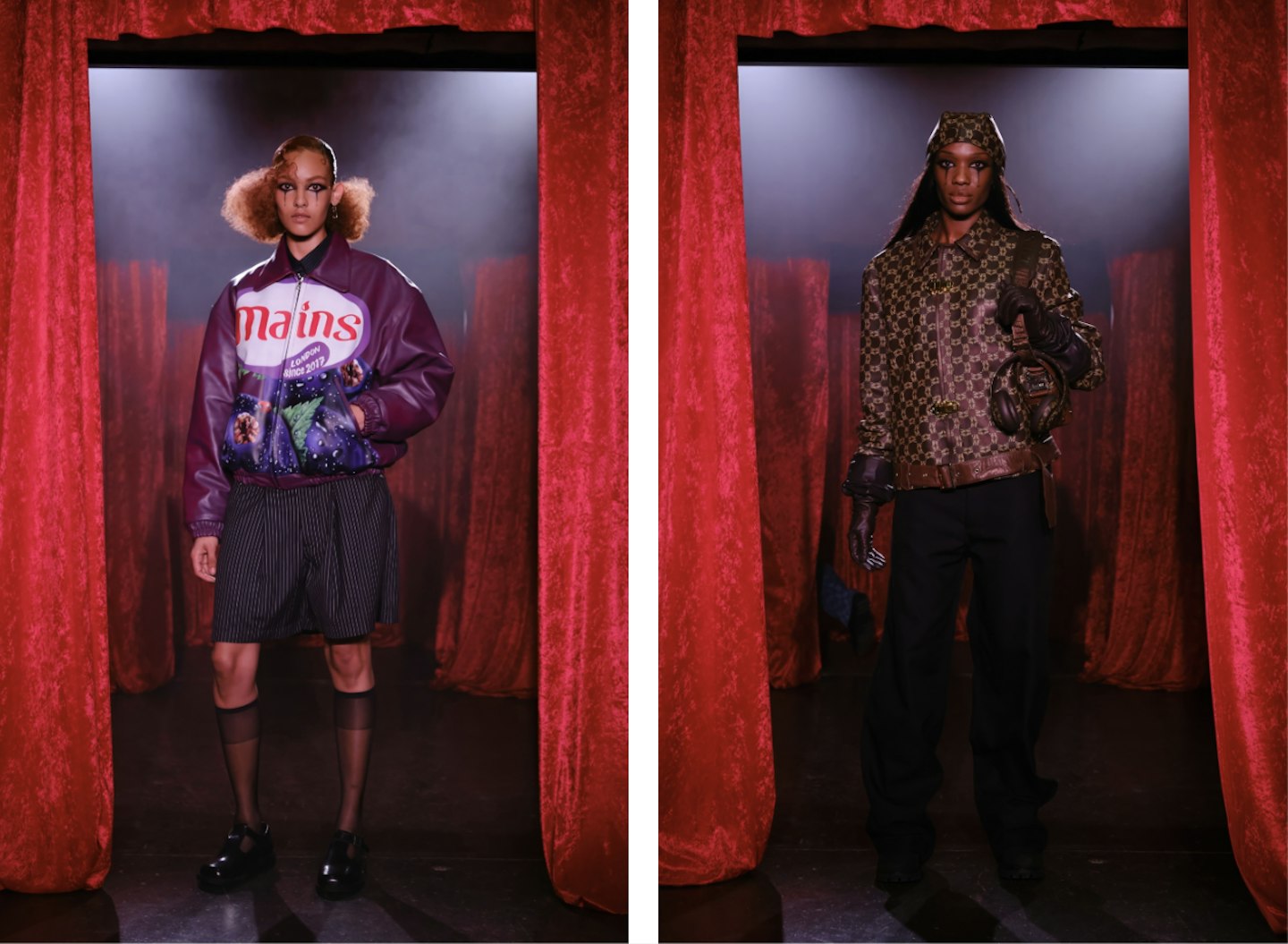
Skepta’s third Mains London show, EUROTRASH, felt like stepping into his younger self’s imagination and in many ways, ours too. He called it a trip into his Pandora’s box: nights spent wide awake in Tottenham, flicking through TV channels, raving to Jungle and Garage, and dreaming about the day he could afford designer clothes. That restless, creative energy spilled straight onto the runway.
The clothes moved between sharp, statement pieces and playful, almost childlike fantasy. One of the standouts - the Ribena inspired jacket - had the whole room smiling and phones immediately up, while the rest of the collection proved Mains has grown into a brand with real range.
The front row made the night just as special. Maya Jama, Central Cee, Headie One - it felt like a proper celebration of UK Black culture, everyone showing up to back Skepta’s vision.
With EUROTRASH, Skepta reminded us of the kid inside all of us the one who stayed up too late, dreaming in colour and imagining a world bigger than our own. RW
Roksanda

‘She has been an inspiration for a very, very long time,’ said Roksanda Ilinčić backstage, of the sculptor Barbara Hepworth who has long influenced the shape of the designer’s work. Roksanda, who this year celebrates her 20th anniversary in business, issued a standout collection in the ballroom of what used to be the American Embassy on Grosvenor Square; now a luxury hotel, The Chancery Rosewood.
There aren’t many designers, particularly in London, who can claim a 20-year body of work - that takes some grit and, of course, a rock-solid signature. Part of the reason for her longevity in a business with the attention span of a gnat, is that she has created a look that is her own; it wouldn’t be difficult to pick a Roksanda dress out of a line-up, such is the strength of silhouette, intensity of colour and sheer discipline that has forged her fashion identity. That, and the fact that women love to wear Roksanda, means that the designer can bring back pieces from her past that still look modern in 2025. Here, the Margot dress from spring / summer 2012 reappeared in orange and lapis blue bonded duchesse satin; the Anya dress from 2016 and Cataline dress from autumn / winter 2022 were reimagined in painterly prints.
Signature Ilincic included the body sculpted dresses with pebble shaped cut outs, teamed with bags formed from slashed leather. One extraordinary dress in chocolate bonded velvet had a skirt that stood away from the body in a wavey circle that looked as if it had been turned on a potter’s wheel, its hem flowing leather ribbons. Unforgettable was the giant lapis cape that billowed with every stride and the raffia that added stripes of texture to the hem of a ball gown, a stole around the throat of a plain black dress or a striped bounce to the skirt of a corset dress worn over strict black trousers. It’s a skill to make raffia resemble soft, fluffy feathers.
The polish and sophistication of this collection will appeal (as it always does) as much to the modern art set as the world’s wealthy; it’s easy to see why so many women trust her – and long may it continue. RL
Patrick McDowell
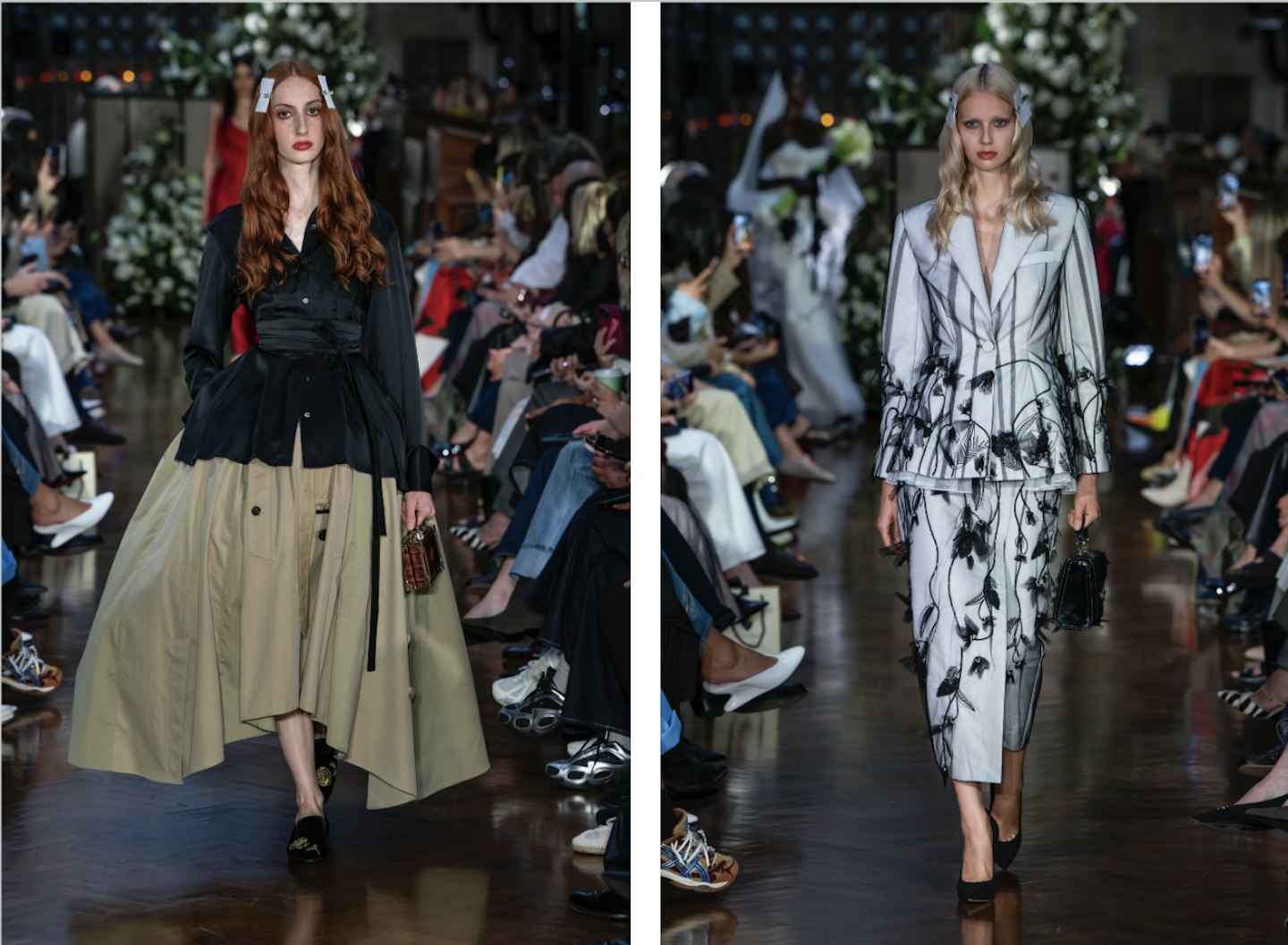
Patrick McDowell debuted his new ready to wear line inside the meticulously restored control room at Battersea Power Station – against a wall of dials, levers and gauges, once the beating heart of the Brutalist structure that distributed power to London from the late 1920s. The backdrop could not have been more fitting, since this was a love letter to the designer’s late grandmother, born 10 June, 1923 – as noted in a reprinted version of her passport, placed on every chair at the show. A Lancashire lass, a laundry worker by trade, mother of eight, and a life that spanned ten decades. It was a very touching nod.
McDowell has built a steady clientele and can boast a roster of private clients who come to him for special made-to-measure pieces, so the ‘Lancashire Rose’ collection is the first time he has produced off-the-hanger ready to wear – and it was strikingly well done.
There were plenty of fluid, 'easy' pieces - long body skimming dresses, sinuous trousers, great shirts - but the real stand outs made you think of black tie dinners, wedding guests (or bride) and especially the red carpet - these were not clothes to go raving in and forget tackling the tube to work.
It was far easier to imagine their end use on the uber polished personas that flash up on our feeds. Such as exit 2 - the gold jacquard jacket nipped in at the waist and standing out over the derriere with gauzy folds beneath and giant black satin trousers being worn by Cate Blanchett to the Venice film festival. Or if Charli XCX felt like being chic, you could see her in the bra top bedecked with silver chains and sewing thimbles. And, come to think of it, Jenna Ortega in that starched all-white look comprising shirt embroidered with a single black rose, cinched over an ankle grazing skirt would be an ideal look for the raven haired mini-goth. No surprise, then, to see Elizabeth Saltzman sitting front row; the celebrity stylist who dresses everyone from Gwyneth Paltrow to Jodie Comer.
McDowell’s collection speaks to London’s grown-up polish that we’ve witnessed so much more of this week. His was a sophisticated two fingers up to anyone who might question London’s design diversity. And, what’s more, is grandmother would be so proud. RL
Chopova Lowena
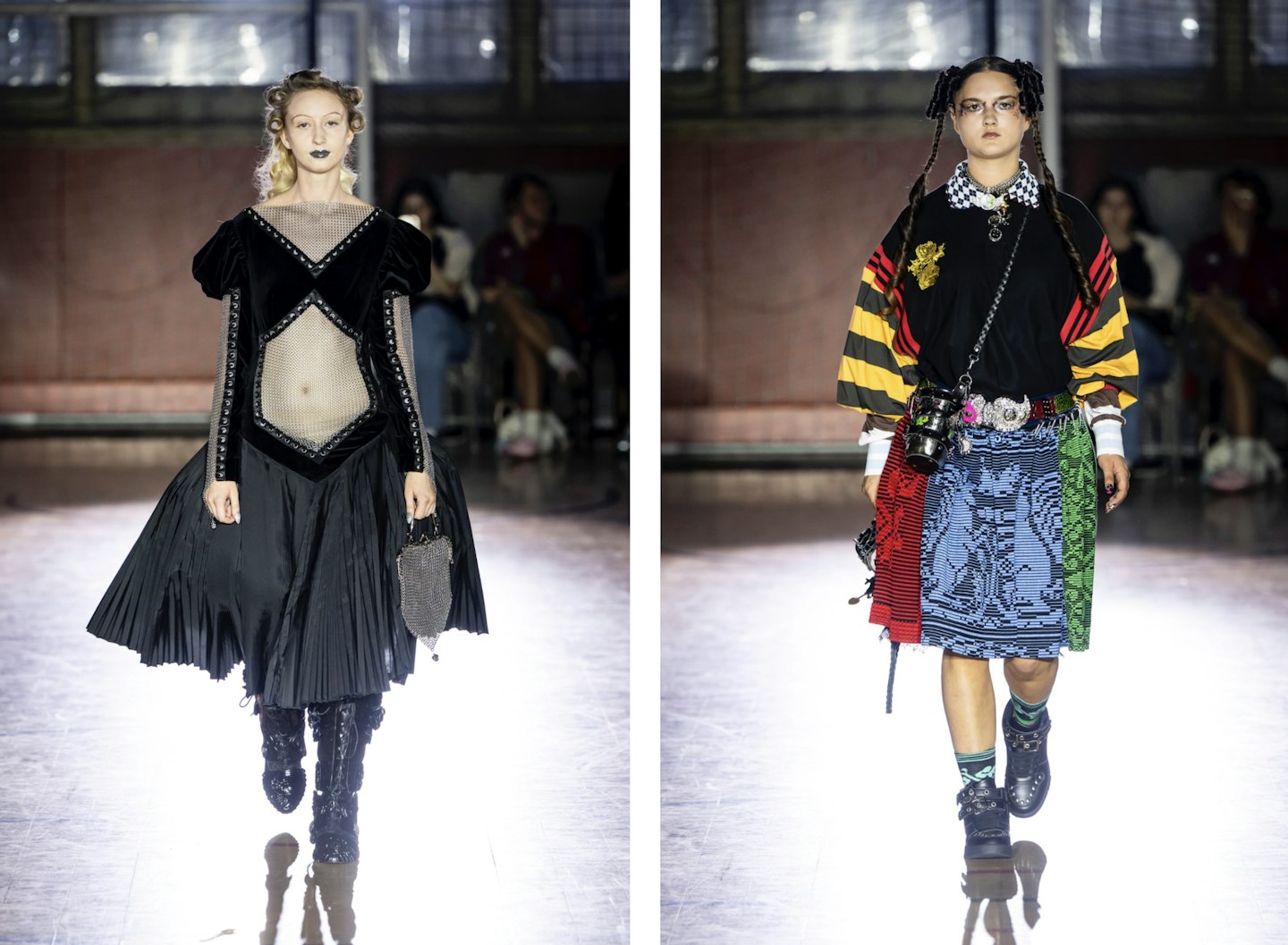
If being picked last in PE ever haunted you, Chopova Lowena’s spring/summer ’26 offered instant redemption. Emma Chopova and Laura Lowena-Irons staged their cultishly adored spectacle in the sports hall of West London’s Harrow Club, where the mantras read: ‘There is no ‘I’ in team but there is on individuality’ and ‘In the Chopova Lowena clubhouse we’re all on the same team.’
The uniforms? Punk-babydoll-folk hybrids reinterpreted through satirical sports tropes: jerseys, track pants, football lace-up bras, ball bags - ‘a hardcore uniform for girls on the field and under the bleachers’. Naturally, the carabiner kilts returned, but to call them the whole story would undersell a brand whose visual language is so singular it’s crossed TikTok into cult status IRL.
This was immersion, not just fashion. A gargantuan inflatable pig loomed outside, branded candles and perfumes lined the stairwell, mascots in fuzzy suits handed out snacks. Inside, a completely bonkers jamboree of genres blasted through the speakers as models stormed the runway - their high-octane hair sculpturally braided, teased and accessorised, their makeup doll-on-acid OTT.
The clothes were equally turbocharged: massive faux fur coats, tiered dresses, in-your-face belt buckles inspired by Bulgarian folklore; bustled velvet gowns, 3D-printed boots, leather harnesses dangling charms and water bottles; bustled black velvet dressss and hints of denim. ‘Cheerlore’ wasn’t a surprise so much as a testament: a pulsating visual world entirely theirs.
More proof, if any were needed, that Emma and Laura have built not just a label but a world. One you can’t quite explain, but want desperately to join once you’ve stepped inside. In the spirit of their show notes: ‘Lace up your boots, clip on your skirt, let’s fucking GO!’ HL
Fashion East
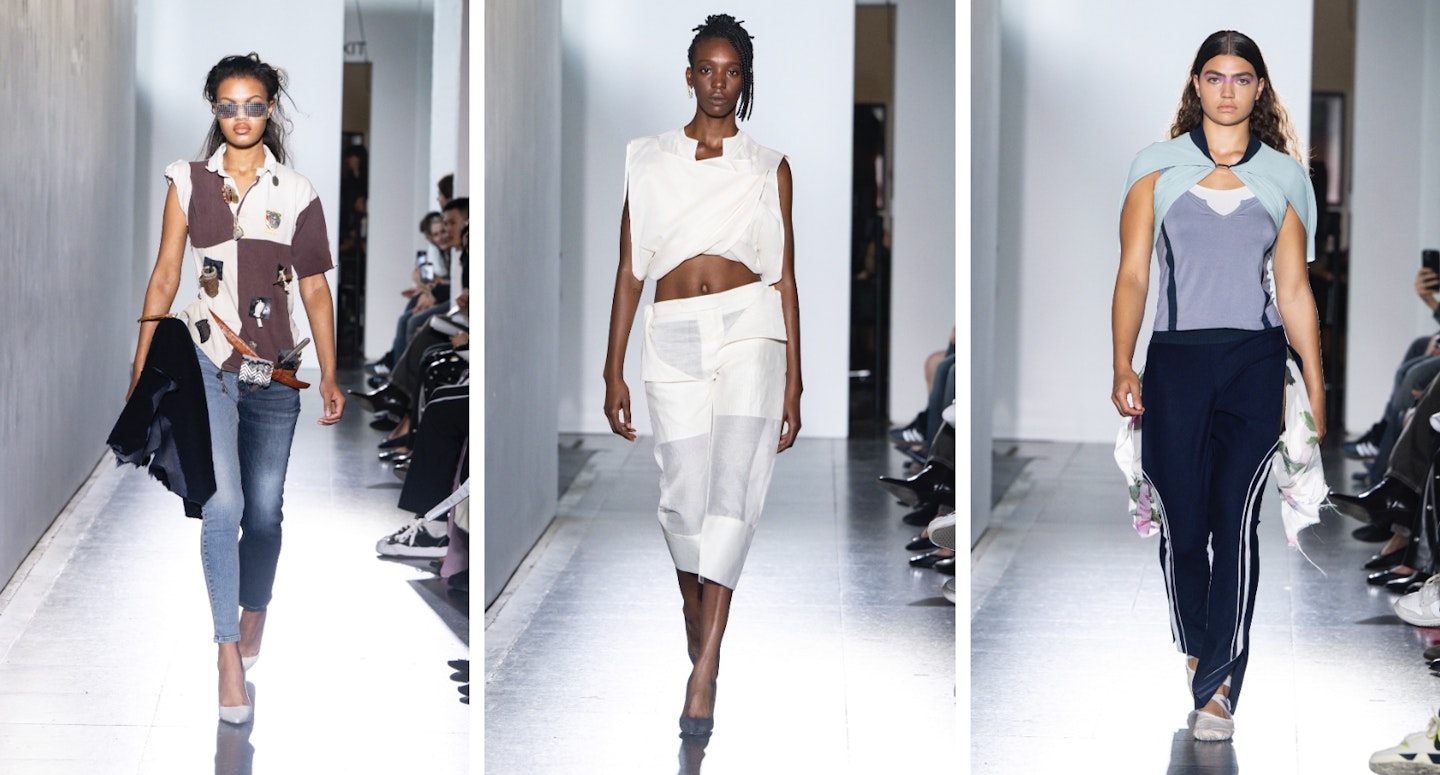
Happy birthday, Fashion East. The talent incubator founded by Lulu Kennedy and Raphaelle Moore - the launchpad for Simone Rocha, Jonathan Anderson, Wales Bonner, Maximilian Davis and Kim Jones - turns 25 this season. The anniversary comes marked with a retrospective exhibition at the Institute of Contemporary Arts, a flurry of events, and, naturally, a runway presentation of the latest cohort. On Friday afternoon, the ICA belonged to Mayhew, Nuba and Jacek Gleba.
Mayhew opened with ‘Hard Graft’, a study of workwear refracted through the eyes of someone in the trade. A painter and decorator by day, he reworked track pants and paint-splattered tees, pieced leather scraps into tops fastened with cable ties, and festooned looks with toolbox detritus - crocodile clips, pipes, zip ties, even an épée grip and a table knife, much of it found mudlarking in the Thames.
Cameron Williams of Nuba followed with a meditation on migration and belonging. His silhouettes were soft, languid and fluid: part daywear, part evening, part draped, part deconstructed - a quiet commentary on cultural adaptation, rooted in his own experience.
Closing was half Spanish half Polish Jacek Gleba, whose collection was a hymn to movement and colour, informed by his education as a dancer. Shades of pink, navy, green and yellow layered into sheer chiffons that trailed through the audience; his riff on the off-duty dancer’s uniform felt both exquisitely crafted and genuinely new.
Yes, Fashion East is 25. But more than nostalgia, its power lies in its forward gaze - nurturing boundary-pushers and safeguarding London’s reputation for the shock of the new. It’s not just an incubator program, it’s a lifeline for anything that London fashion stands for globally. Here’s to the next 25. HL
Labrum
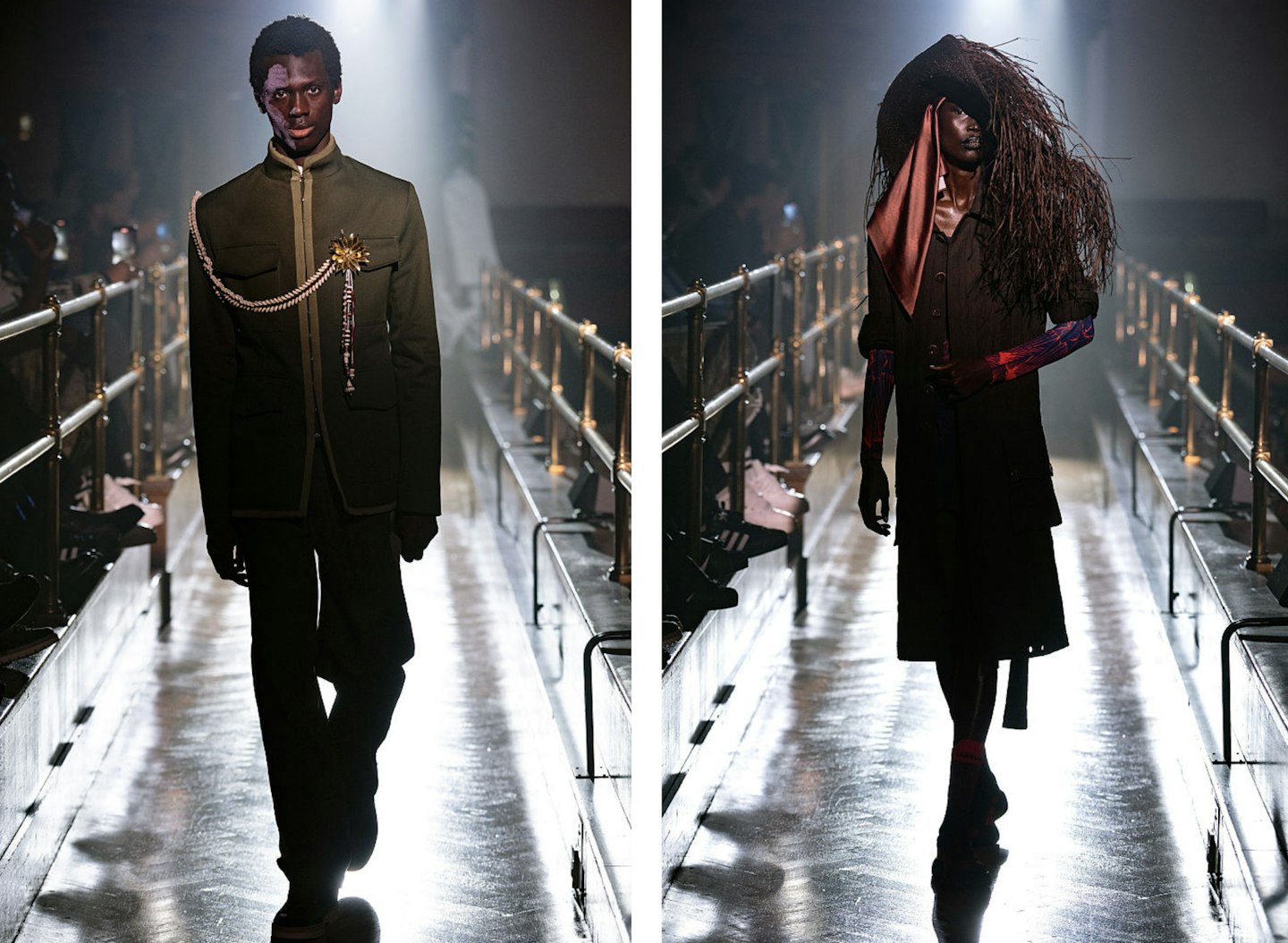
Labrum’s Cultural Osmosis (Part 1) took everyone at Central Hall Westminster on a journey - one that stretched from the past to the present. It showed how culture spreads and shifts when different communities cross paths.
Looking out across the sea of red seats, I saw laughter, joy, and even a few tears. The clothes carried that same emotional weight. Many of the pieces were rooted in West African culture, full of stories from those who walked before us. Foday Dumbuya tucked symbols throughout the collection: the cowrie shell, once a marker of wealth across much of Africa, now given new lease of life.
Heritage echoed everywhere: Zulu headdresses, sharp military-style tailoring and earthy tones. Each element felt like threads connecting, weaving together a tapestry of generations. The models wound their way down the orchestra pit in a slow winding procession. The length of the runway itself felt symbolic - a reminder that the journey of cultural exchange is never quick, never straight, but layered and ongoing.
Live music drove the point home. Jazz folded into soul, which slipped into African rhythms - a soundtrack of cultures blending into each other. Even the audience felt like part of the show, a mix of people whose very presence mirrored the idea of cultural osmosis.
As Edward Said (1978) once wrote, ‘cultures do not simply exist they interact, influence, and concurrently shape one another.’ Dumbuya’s show was a living illustration of this truth. Those who came before walked, so many more could run. RW
Oscar Ouyang
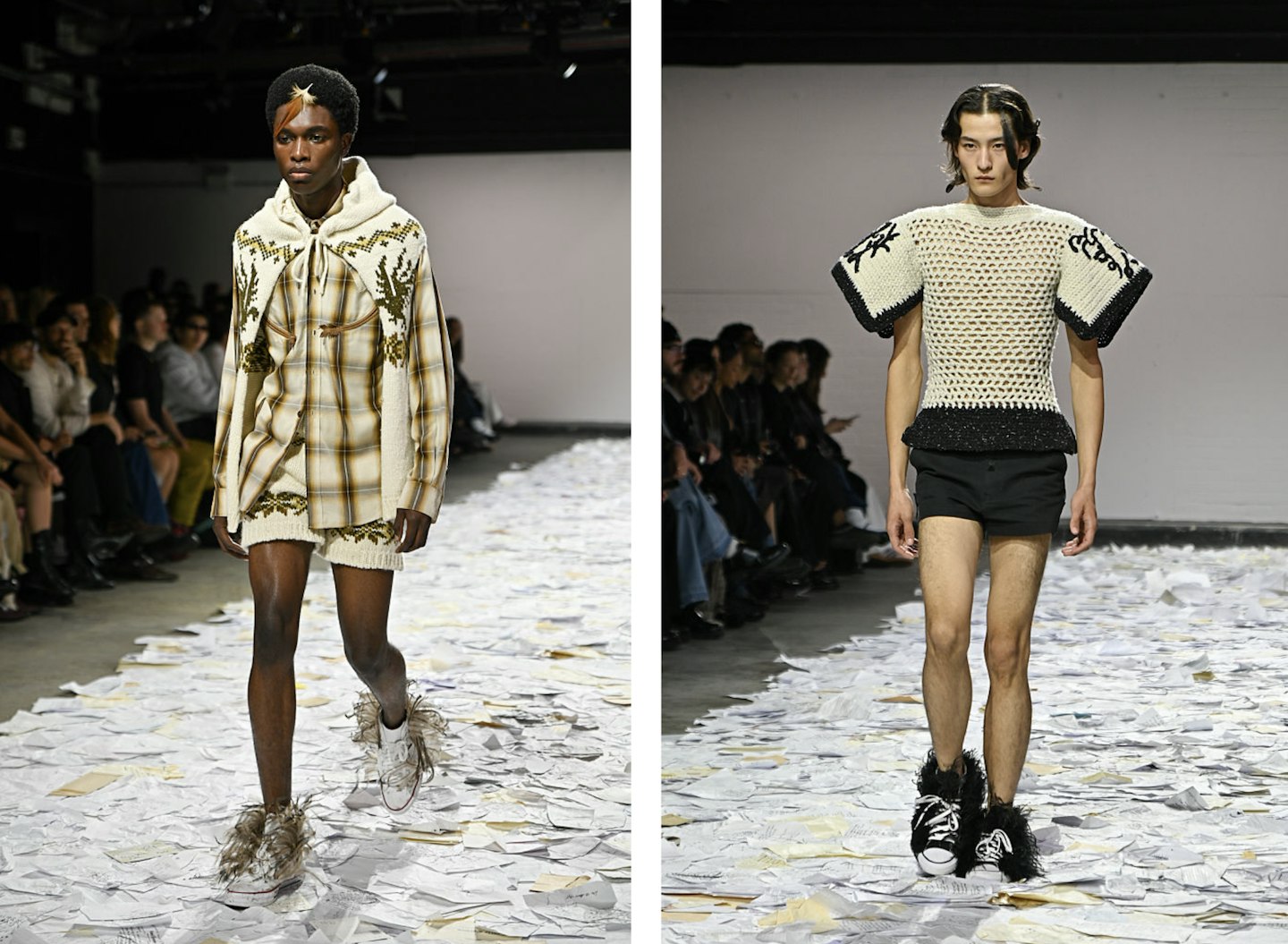
Every so often a new name slips onto the London schedule, trailing whispers before a single look has hit the runway. That alchemy is what keeps London Fashion Week fizzing - and day two belonged to Oscar Ouyang.
The Guangdong-born knitwear designer and freshly minted CSM graduate had already been anointed ‘one to watch’ before his debut on the opening morning. As part of the NewGen cohort, Ouyang staged his show at the BFC space, transforming it into a theatre of messages: crumpled mounds of letters underfoot, origami cranes perched on seats, wings inscribed with the collection’s title, Don’t Shoot the Messenger.
The clothes extended that romance, tempered by craft. An army jacket edged with feathers opened, shrugging over knit shorts. Soon came Ouyang’s métier: knitwear pushed, slashed and sculpted into unexpected guises. Fair Isle unraveled over plaid western shorts; sculptural, inflated tops; feathered beanies and knit leggings nodded to whimsy. Shoulder-broad tops in knit and jersey carried a swagger, while crochet tops added another stitch in his growing lexicon.
T-shirts sprouted angel wings, plumes fluttered from models’ hair, and with each exit Ouyang asserted what London does best: visionary experimentation that thrills anew. If his debut is the measure, he is the kind of designer to make you fall in love with fashion all over again. Henrik Lischke
Harris Reed
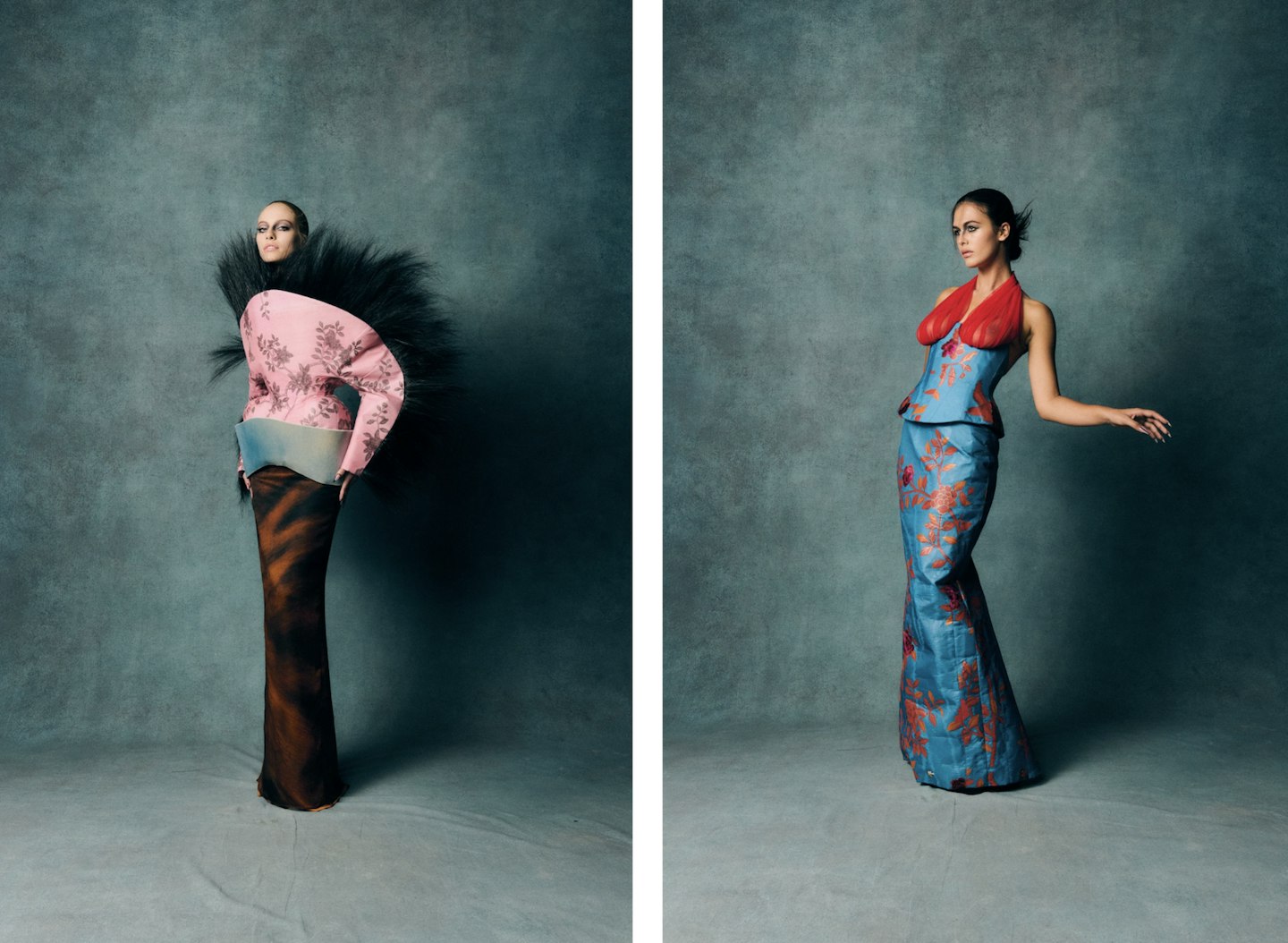
Harris Reed’s fashion illustrations came to life in the Gothic Bar at St Pancras – a fitting location, since Morticia Adams, in a corset and fishtail velvet, would not have looked out of place. Aside from the fact, however, that this was not a collection written in black and blood red, but vivid colour and golds, with fine fabrics like silks, duchess satins and damasks, sometimes resembling hand painted canvas.
Reed’s super-attenuated silhouettes grew out of whomping black platforms that made the models reach seven feet tall. Corsets, that whipped in waists and sometimes accentuated shoulder lines with a spray of feathers, were given the lead role in his story. But what was his story?
As onstage costumes, these were often brilliant feats of engineering – particularly the first exit, a golden corset that had been split away from the body in two giant curled leaves, or the corset-trouser combo printed in vivid denim blue feathered wings.
You can’t deny the visual storytelling, or the finger-bleeding work that goes into his craft, but it’s 2025 and – though we don’t want real life wearability from Reed – it could be interesting to see what he’d do with some real world parameters, just to see where that imagination could take him, not just at Nina Ricci but under his own brand, too. That said, whoever wears these on-stage one-off costumes, will be hyper photogenic. Rebecca Lowthorpe
Ebay
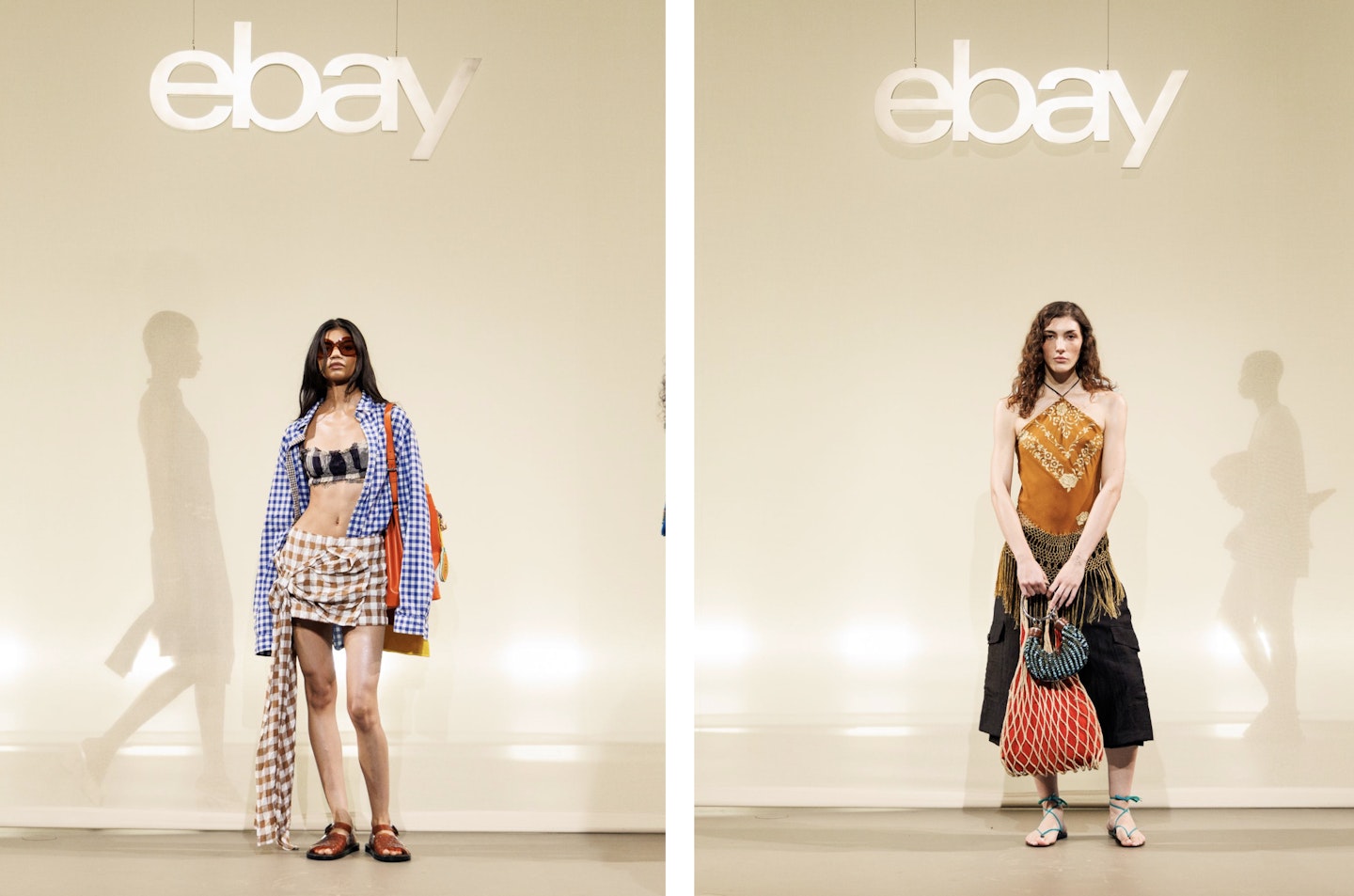
Kicking off LFW, eBay’s Endless Runway show proved that second-hand fashion is well and truly alive and kicking. Styled and curated by UK Pre-Loved Style Director Amy Bannerman, and hosted by newly minted Pre-Loved Fashion Ambassador Amelia Dimoldenberg (who brought her trademark wit to the front row), the night set out to show just how exciting resale can be.
For years, resale has been knocking at the door of high fashion. This season, eBay flung it wide open. For Spring/Summer 2026, the Endless Runway project returned with a bigger, bolder proposition: pre-loved treasures woven directly into major designer collections.
ERDEM, Altuzarra, Kallmeyer, LUAR and Ahluwalia were all game, reworking everything from archival runway looks to everyday staples. The vibe? Relaxed, wearable, and very much what you’ll want to be living in next summer.
Highlights included an iconic Alexander McQueen skull scarf, Bode’s playful fish bag, and a glittering Givenchy sequin dress that closed the show on a high. For anyone not in the room, the runway was streamed live with shoppable pieces available at the click of a button. Renee Washington
Henrik Lischke is the senior fashion news & features editor at Grazia. Prior to that, he worked at British Vogue, and was junior fashion editor at The Sunday Times Style.
